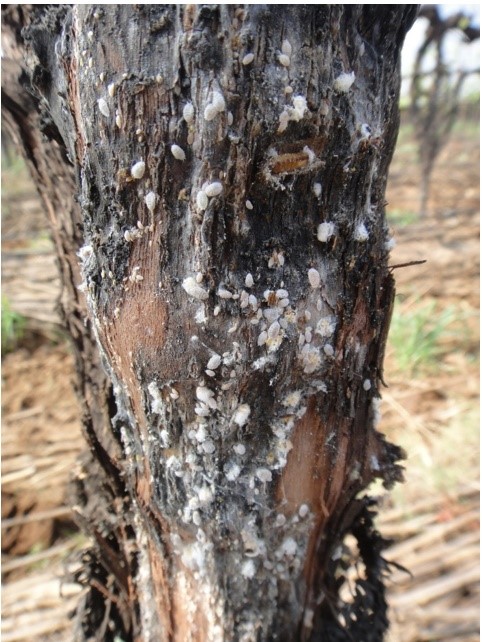Pheromone based attractant compound for Pink Mealybug

Background:
The pink mealybug, Maconellicoccus hirsutus, is a polyphagous pest infesting large number of host plants belonging to 76 families and 200 genera including beans, chrysanthemum, citrus, coconut, coffee, cotton, croton, cucumber, grape, groundnut, guava, hibiscus, maize, mulberry, pumpkin and rose. The nymphs, crawlers and adults of the pink mealybug suck the sap from the trunk, cordons, aerial leaves, shoots, nodes, panicles, bunches and even roots. They inject their toxic saliva into the plant parts during feeding thereby resulting in malformation, crinkling and stunting of infested plant parts. The sugary honeydew excreted by the pink mealybug lead to the growth of sooty mold fungus thereby affecting the photosynthetic ability of the leaves. The sooty and sticky bunches harboring the pink mealybugs and their white cottony wax masses are unfit for marketing as table grapes. Under severe infestation of mealybugs, yield losses of around 50 percent has been recorded in grapes.
The management of pink mealybugs from infesting the plants is complicated by several factors. Firstly, the lack of efficient mealybug detection and monitoring tools. Secondly, mealybugs are capable of locating themselves inside the protected sites of the crop like cracks and crevices of the bark, trunk, under surface of the leaves and in berries which hardly get exposed to the chemical sprays. The cryptic behavior of the insect renders the chemical measures of management of the insect ineffective. Thirdly, the protective waxy covering over the body of pink mealybug prevents the insecticides to gain entry into the body of pink mealybug to control the insect. On the other hand, over relying on use of insecticides creates issues with residues in the harvested produce, development of resistance in the pink mealybug and secondary pest outbreak making the pest management situation worse.
Further, since parthenogenesis is the major mode of reproduction of the pink mealybug and the population of male pink mealybugs is very low under field conditions, the utility of attractant pheromones has not been considered.
Technology Details:
The innovation describes a method for isolation, identification and synthesis of an attractant pheromone compound followed by bio-assay to control infestation by pink mealybug, Maconellicoccus hirsutus on grapes. The structure of the isolated pheromone compound has been identified. Further, the attractant properties of the isolated/synthesized pheromone are established to further enable it in making pheromone traps.


